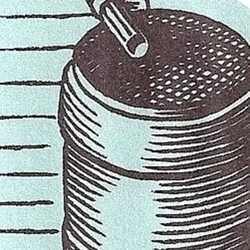Homes built in the last fifty years were NOT designed to accomodate rain water harvesting. Those adding rain barrels to such a home often discover obstacles and inconveniences to rain barrel use. Manufacturers are busy working on efficient, leakproof ways to get water into the barrels, and handy add-ons for conveniently using our rain water. I've surfed the internet for rain barrel accessories. Below are descriptions of some of the offerings, reasons why you might want one, and links so you can see various products.
Rain barrel and accessories offered at Ace Hardware in Edgewater, Maryland
Downspout diverters: How do you get water in the barrel without causing drainage problems around the house?
Diverters are downspout adaptations that direct rainwater to the barrel. Designing a diverter sounds simple but presents challenges. The device must send water to the barrel but not overflow near the house or clog with leaves or ice. The original concept for rain harvesting called for shortening the exisiting downspout, then installing an elbow. or downspout extension, to carry water to the barrel. This works well on a barrel with a large screened inlet and a properly placed and sized overflow. (Rain water must not leak and pool next to a house foundation.) Before freezing weather, the barrel must be removed and the downspout reinstalled for proper drainage. That seasonal downspout changeover leaves some folks yearning for a maintenance-free alternative.
Next to come along is the "Save the Rain Water Metal Diverter" offered at Rainbarrelsource.com. This device adds a section of downspout with a moveable front flap. The flap is flipped down to send water to your barrel, or flipped up to send water on its normal gutter path. There's no seasonal change other than a flip of the flap, and winter storage of the barrel. A more ambitious device is sold at Aquabarrel.com, and by many other sources. This diverter uses downpout material and a special "splitter" piece to construct a bypass spout. This system stays in place year round and seasonal change is a flip of a lever. Your barrel must have an overflow.
Now there are several versions of "third-generation," high tech diverter. These are somewhat sleek and are permanently installed in the downspout. Water leaves the diverter through a secondary tube and enters the rain barrel. This may allow you more choice in placing your barrel. Some of these units are designed for a sealed barrel system. When the tube is sealed to the barrel, a full barrel and tube causes overflow to occur in the existing downspout.
Rainbarrel.net offers a reservoir diverter with dual outlets for two barrels (and detailed pictures which give a good idea of how the thing works.) Fiskars (and possibly others) makes a permanent in-line diverter which is mounted at the height of the rain barrel. The tube is attached and sealed to the side of the rain barrel. On this diverter, overflow occurs when the barrel water level reaches the tube level. Click here to watch a Youtube video of the Fiskars diverter in action. The rain barrel user in the video seems pleased with the device, but does point out the potential for leakage.
All diverters should be scrutinized after installation for leakage during heavy rain, and clogging with winter ice. Whichever diverter you choose, you must still winterize your rain barrel.
Connectors and spout kits make it easier to make your own barrels, and let you link barrels to add storage capacity
Instructions for making rain barrels from plastic drums often list all the parts for spout assembly. Now kits are sold containing all the parts for a spout. And should one barrel not suffice, you can simply add a second barrel and link it with the first. Buy a linking connector and join your barrels. Place all barrels at the same height.
Pumps: The gravity flow of rain barrels can be annoyingly weak
Rain barrel output pressure is very low. It's fine for filling a watering can, but a sprinkler or hose nozzle won't work unless you boost the pressure. According to Doug Pushard at HarvestH2O, "sizing a pump correctly is not straightforward and installers often fail to make the appropriate calculations." Serious rainwater users will want to read the entire article, and more, at HarvestH2O.com before buying a pump.
Casual backyard gardeners might be satisfied with one of the pumps marketed to the homeowner. A number of companies sell a solar powered water pump for rain barrels. The electric pump sold at Rain Barrels R Us plugs into an outlet and installs easily right onto the barrel's hose bib. This submersible pump is sold for rain barrel use. Wayne Pumps recommends their 1/6 horsepower submersible pump for rain barrel use. Cleanairgardening.com offers a battery powered pump. According to the product description, this pump's utility seems limited.
Rain barrel rated soaker hose or drip irrigation eliminates the need for a pump
Rain barrels use only gravity to force water from the spout. Conventional soaker hoses will not work with a rain barrel. Buy a specially designed, low-pressure rain barrel soaker hose. Rainbarrelman.com shows options in soaker and drip systems that will work when connected to a rain barrel.
Roof washer or first flush device keeps stored water cleaner
Roofs get dirty and rain barrel water held for periods of time can get dirty too. This is of no major concern for the garden but may be unpleasant for the gardener. For household use of rainwater, sanitation becomes important. A roof washer, first flush device, or first flush diversion valve lets the dirtiest rainwater drain off before sending the rest of the rainwater to the barrel. More effective filtration roof washers are recommended for household use of rainwater but not required on a "garden" rain barrel.
Rain barrel stand elevates the barrel and is more attractive than cinder blocks
Rain barrels are raised to create more pressure for the outlet, and height under the spout so you can fill a watering can. Commercial stands are shaped to allow room around the drainspout. They also come in various plastic colors, in case your rain barrel is NOT cinder-block-gray.
Water level gauge
How can you tell how much water is in a solid, opaque barrel? With a gauge like the one sold at Rain Barrels R Us.
Last but not least? A "snuggly" cover to tuck the barrel in for winter
Empty the barrel below the level of any working parts, then cover it for the winter to keep more water from entering.
Your choice
Given the range of stylishness, effectiveness, and cost involved in these accessories, I'm not qualified to recomend any in particular. Nor do I reommend these particular vendors, as I haven't patronized any. Those just planning for a rain barrel now know that more may be needed for a fully functional system. Those already using a rain barrel might be inspired to improve the system by seeing the array of products out there. With the assortment of add-ons out there, any rain barrel installation can be as useful, stylish and cost effective as you'd like it to be.
Resources
HarvestH2O.com is the most informative of the sites I found while researching. http://www.harvesth2o.com/about.shtml accessed 7-21-2012
Read a civil engineering view of rainwater harvesting here- http://theconstructor.org/water-resources/methods-of-rainwater-harvesting/5420/ accessed 7-28-2012
Thanks to Ace Hardware in Edgewater Maryland, for allowing my picture of items in store

















